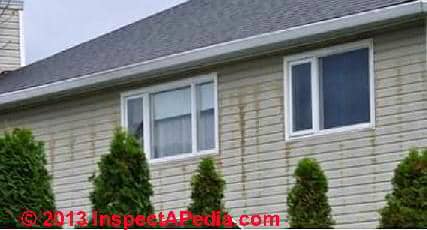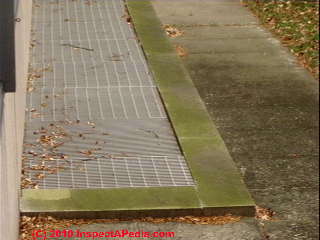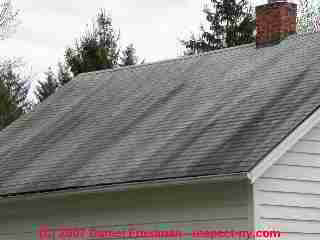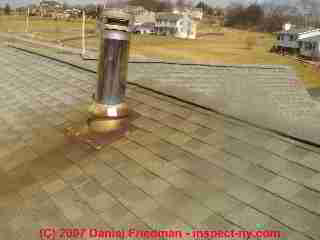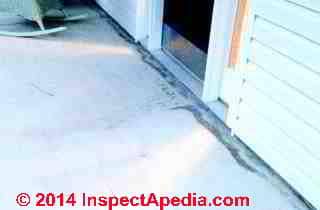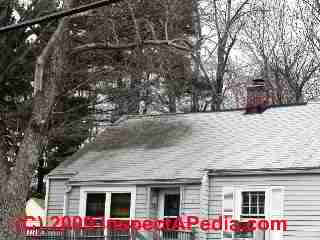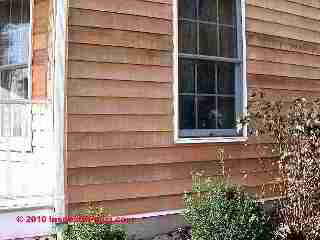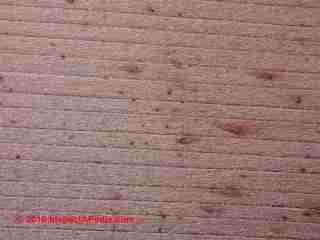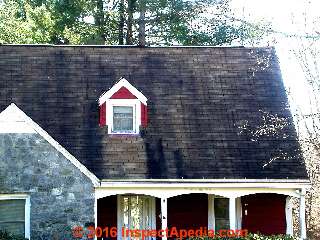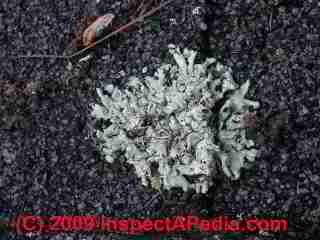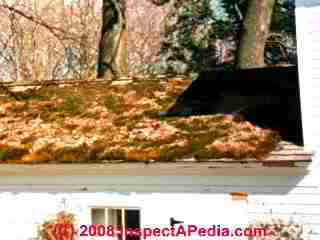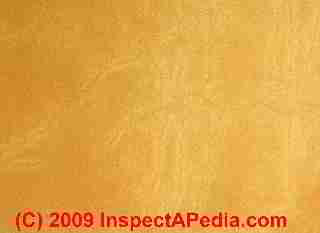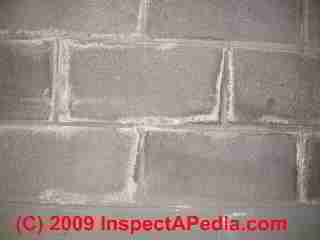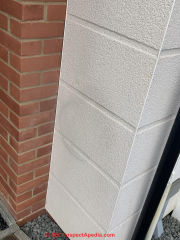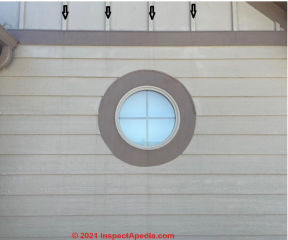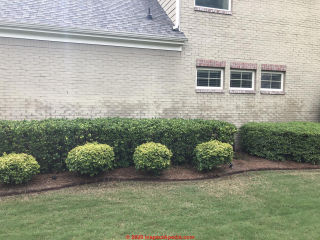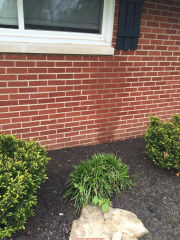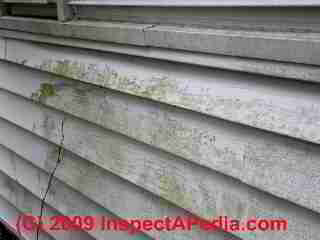 Encyclopedia of Stains on Building Exteriors
Encyclopedia of Stains on Building Exteriors
How to Identify the type, cause, & cure of stains
- POST a QUESTION or COMMENT about how to identify types & causes of stains on building exterior surfaces
Building exterior stain cause diagnosis & cure:
This article provides a catalog of the different types of stains or discolorations found on building exterior surfaces: walls, roof, trim, walks, patios, decks, etc. We discuss each stain by color, type, cause, and cure. Diagnostic & Photo Guide to Stains on Chimneys, Foundations, Masonry Surfaces, Roofs, Walls, Floors, Concrete.
We include links to references useful in the identification of algae, moss, lichens, pollen and mold. Our page top photo shows algae growing on the shaded side of a vinyl-clad building
InspectAPedia tolerates no conflicts of interest. We have no relationship with advertisers, products, or services discussed at this website.
- Daniel Friedman, Publisher/Editor/Author - See WHO ARE WE?
Cause & Cure for Stains or Marks on Building Exterior Surfaces: roofs, walls, decks, siding, trim
In the following guide we list types of stains by stain color & appearance, by building location or material, and by stain cause.
[Click to enlarge any image]
We distinguish among the following stuff that may stain or be found growing building roofs, walls, or other surfaces, with extra focus on asphalt shingle roofs as well as other roofing materials such as wood shingles, wood shakes, roll roofing, and even slate or tile roofs.
Our photo (left) contributed by professional home inspector Hugh Cairns in British Columbia is a classic example of the combination of thermal bypass temperature variations marking the locations of studs in a wood framed exterior wall.
Temperature variations across a building surface can often explain the pattern of algae growth and in some cases mold growth on building surfaces as well as the more harmless accumulation of dust and debris. [Click to enlarge any image at InspectApedia] Mr. Cairns writes:
The attached photo shows vertical staining on vinyl siding on a home in central British Columbia.
The repeating vertical pattern of the organic material is consistent with the placement of repeating exterior wall studs. The material is untested and as such its organic composition is unverified, however the appearance of the substance is consistent with algae or mold.
The patterned staining may be a result of surface condensation due thermal bridging, where localized surface temperatures from each piece of framing lumber act as a conduit for heat transfer allowing moisture and dust particles to gather and create favorable conditions for organic growth. [1]
Some types of building stains or discoloration are only cosmetic in nature, while others may indicate growths that are likely to reduce the life of the material such as roofing, siding, or trim.
- Algae Stains (usually green or brown, sometimes black): Algae very often appears as a flat green coating or stain on building siding and even on sidewalks and concrete (photo above).
Algae often causes black stains on roof surfaces and green stains on other building exterior surfaces such as concrete (photo above left), decks, and building siding (photo below).
See ALGAE, FUNGUS, LICHENS, MOSS COMPARED for additional photos (including algae in the microscope) and details.
Below the black streaks on light colored asphalt roofing (photo below left) are usually identified as a specific algae.
More photos of black algae stains on roofs are
at BLACK ALGAE STAINS On Asphalt Shingles.
For details about why roof algae forms and what can be done about it
see ALGAE STAINS ON ASPHALT ROOF SHINGLES.
Our photo at above right is a magnified view of tiny black dots on building siding that will probably be identified as a fungus, but algae is more common than mold on most exterior siding, particularly vinyl siding where it may appear as a green, brown, or black "stain".

- Algae or Mold Stains on Building Siding may be due to a combination of shade, moisture, and a building surface that uses a material or coating that is particularly conducive to algae or mold growth.
Our photo (left) shows black staining on painted wood clapboards on an older building in New York state.
Without closer examination and maybe a lab test, we're not sure if the black stains are algae or a mold, but in either case the causes are the same: moisture, shade, and from the stain pattern, possibly the absence of insulation and a moisture barrier in the wall structure.
Siding stain clean-off recommendations
From Best Practices Guide to Residential Construction (Steve Bliss, J Wiley & Sons) :
To remove mold ("mildew") from building surfaces, use a sodium hypochlorite solution, which can be made with household chlorine bleach. Depending on the severity of the problem, the solution should range from 1 to 8 parts bleach to 1 part water.
Spray the solution onto the siding (avoid sprayers with aluminum parts), starting at the top and working down. If two applications do not remove the stains, you may need to scrub in the solution with a brush. Thoroughly rinse everything with water.
Bleach can harm plants, discolor the finishes on trim, and corrode aluminum, brass, and copper. It is best to cover plants with tarps and protect any stained or painted surfaces.
Above: black stains on the exterior of a church wall on the island of Corsica in 2016, courtesy of E.R. Typically stains like those shown above are found to be either a dark algae or sometimes a combination of algae and fungus.
See details at ALGAE & MOLD STAINS on EXTERIORS
- Black stains on asphalt roofing products and on some other types of roofing (concrete, clay tile) such as asphalt are usually an algae but might on some roofs be caused by extractive bleeding (product defects) shown earlier on this page -
See details at ALGAE STAINS on ROOFS and
see EXTRACTIVE BLEEDING on SHINGLES and
see STAIN DIAGNOSIS on ROOFS environmentally-caused roof shingle stains. - Brick stains: causes & cures of & for stains on brick surfaces
See STAINS on BRICK SURFACES
- Tarry black vertical run-down or bleed-out stains:
A reader asked about black streaks appearing down the building siding and originating from tarred top tile covering of a roof parapet.
If that's the stain source on your building, ask the installing roofer to either replace the tar (more-likely flashing cement) with something non-staining (an ugly job) or you might experiment with a sealant or coating, even silicone, atop the existing material.
The problem is getting any cover-over to bond. So ultimately you may need to cover the tarred joints with aluminum flashing that's siliconed in place to stop the weathering of what looks like poorly-formulated bleeding-out flashing cement.
- Black stains on vinyl or painted building exterior wall siding may also be mold, as our photo shows at above right.
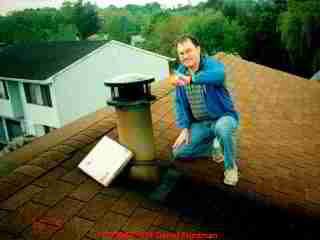
- Black, brown, or gray stains on roofing products due to debris left on the roof surface, such as piles of leaves and organic waste from nearby trees.
See DEBRIS STAINING and
see PROXIMATE CAUSE of ROOF SHINGLE STAINS.
Black or other colored stains on roof surfaces may be caused by soot from chimneys, both wood-fired and oil-fired devices. Black or other colored stains may also appear on roof surfaces from nearby industrial activities. - Black or other colored stains on roof surfaces may be caused by soot from chimneys, both wood-fired and oil-fired devices. Black or other colored stains may also appear on roof surfaces from nearby industrial activities.
See Soot Staining.
- Black stains on building interiors: such as on carpets, drywall, or trim:
see STAIN DIAGNOSIS on BUILDING INTERIORS and
see STAINS on INDOOR SURFACES, PHOTO GUIDE
- Black mold in buildings: often is mistaken as being the only or most severe mold problem - be sure to look for other molds that are perhaps equally or more toxic but are harder to spot. Our photo (left) shows cosmetic black mold on building framing.
See MOLD APPEARANCE - WHAT MOLD LOOKS LIKE for complete details,
and see BLACK MOLD IDENTIFICATION for specifics about black mold growth in buildings.
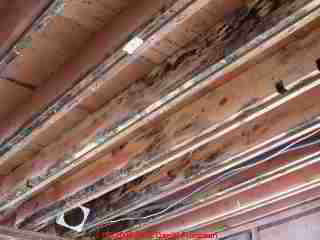
Mold on a building exterior surface indicates damp or shaded conditions, is not normally itself a hazard to building occupants, but it might indicate conditions that have also produced an indoor mold hazard.
- Brown or red stains on roof surfaces are often caused by rust from wearing steel flashing or other on-roof metal products.
See RUST STAINS on SHINGLES
- Chimney stains on roofs near chimneys:
Also see SOOT STAINING - Black Soot Stains on Roof Shingles Around Chimneys and
see PROXIMATE CAUSE of ROOF SHI*NGLE STAINS
- Chimney stains on the exterior of chimneys themselves - s
ee STAINS on/near CHIMNEYS where we discuss stains found on chimney exteriors or stains on building interior walls or ceilings near chimneys.
Also see CHIMNEY-CAUSED ROOF STAINS
- Concrete surfaces, stains on - stains on concrete sidewalks, porches, or interior concrete floors may be ascribed to a variety of sources that we list here.
See STAINS on CONCRETE
Reader Question: what are these black stains on our concrete porch?
4/1/2014 AUTHOR:Rhonda (no email)
COMMENT: I have a problem with my front porch, it runs the whole length of the porch, tried pressure washing it, it didn't come off and seemed to make it worse.
Reply:
Rhonda, the black marks in your photo (shown here so that others may comment) may be due to moisture variations in the slab, moisture from below, or moisture entering the house-slab juncture, possibly bearing staining contaminants.
But most likely we're looking at a combination of variation in concrete hardness and moisture level.
The observation of those round-ish blot stains on the concrete slab surface in front of the entry door
suggest that a door mat was placed there previously, holding moisture in the slab (possibly during curing). Does the stain pattern vary with dry weather?
This comment was originally posted at MOLD APPEARANCE - STUFF THAT IS NOT MOLD
At CONCRETE STAINS: ID & REMOVAL we categorize concrete stains and discolorations into diagnostic groups and we also discuss the causes of concrete stains or discoloration and methods for removing concrete stains. That article also describes products for deliberate coloring or staining of concrete floors, walls, or ceilings.
- Debris stains on roof shingles - see DEBRIS STAINING - Black Debris Stains on Asphalt Shingle Roofs. Debris stains on building walls, including stains from animals may appear as black smudges that may be mistaken for mold.
Excess moisture in wood species such as cedar, redwood, Douglas fir, and mahogany can dissolve the natural tannins in the wood and cause them to migrate to the surface, leaving a reddish-brown stain on the finish.
Details are at EXTRACTIVE BLEEDING SIDING STAINS
- Extractive bleeding stains on asphalt roofs -
see EXTRACTIVE BLEEDING on SHINGLES and
see ROOFING MATERIAL DEFECTS - Graffiti on building surfaces
See GRAFFITI REMOVAL FROM BRICK CONCRETE STONE SURFACES
- Lichens growing on roof surfaces, often a blue-green material -
see ALGAE, FUNGUS, LICHENS, MOSS on ROOFS.
Lichens are not the same growths as moss or algae, and are difficult to remove without damaging the roof surface.
Also
see ALGAE, FUNGUS, LICHENS, MOSS COMPARED.
 Both mold and algae can show up as dark (or other colored) stains on building ecterior surfaces.
Both mold and algae can show up as dark (or other colored) stains on building ecterior surfaces.
These growths may appear on natural wood, stained wood, paitned wood, vinyl, or other plastics, aluminum, and many other materials, even masonry or stone.
Because by visual inspection it is not always obvious if we are seeing an algae or a mold growth on building surfaces, we note that either algae or mold stains on suilding surfaces are principally due to a combination of shade, moisture, and a building surface that uses a material or coating that is particularly conducive to algae or mold growth.
Our photo (above) shows black staining on painted wood clapboards on an older building in New York state.
Without closer examination and maybe a lab test, we're not sure if the black stains are algae or a mold, but in either case the causes of these unsightly stains are the same: moisture, shade, and from the stain pattern, possibly the absence of insulation and a moisture barrier in the wall structure.
Details about mold and algae stains on building exteriors including wood siding, trim, beams, vinyl siding, and other building surfaces are
at ALGAE & MOLD STAINS on EXTERIORS
- Moss on roof surfaces - shown above;
See ALGAE, FUNGUS, LICHENS, MOSS on ROOFS. Green or other colored mosses are a bit easier to remove than lichens on roofing surfaces, but both can carry away mineral granules and damage the roof surface.
Moss tends to hold more water and moisture on the roof surface. So in our opinion moss is more likely to damage a roof surface than lichens or algae.
Also see ALGAE, FUNGUS, LICHENS, MOSS COMPARED.
- Paint on Brick or Stone Surfaces, or stains on brick or stone
See STAINS on BRICK SURFACES where we discuss all sorts of stains and paint removal from brick exterior or interior surfaces; these methods also help clean stone surfaces.
Also see STAINS on STONE, STUCCO DIAGNOSE & CURE - Pollen stains on building surfaces -
see POLLEN STAINS on BUILDINGS - Rust Stains on buildings -
See RUST STAINING - Red or Brown Rust Stains (on shingles) - Roof stains -
See STAIN DIAGNOSIS on ROOFS - home - Soot or Creosote black or brown stains on roof surfaces near or below chimneys
See SOOT STAINING - Black Soot Stains on Roof Shingles Around Chimneys
Also see PROXIMATE CAUSE of ROOF SHINGLE STAINS - Stains on stone or masonry surfaces - stone stains -
See STAINS on STONE, STUCCO DIAGNOSE & CURE
Also see STONE, STUCCO & BRICK CLEANING METHODS for cause, cure, and prevention - Stucco, stains on - black, white, or other color stains or bleed-out on stucco wall surfaces -
See BLACK STAINS on STONE & STUCCO
See also SIDING EIFS STUCCO PAINT FAILURES - where we discuss white stains blooming through painted stucco
- Thermal tracking stains or marks on building exteriors:
Thermal tracking stains such as the vertical stains on the interior walls shown above will not normally be visible on a building exterior, but we might see similar tracking of wall studs or roof rafters (photo below) where temperature differences in a building or points of heat conductivity and heat loss cause variations in snow-melt (on roofs) or moisture condensation (on walls).
And Hugh Cairns' photo of algae streaks on building exterior siding shown near the top of this page are almost certainly related to a thermal break in the wall structure at the stud locations.
Black stains on building interior surfaces may follow a similar pattern (photo, above right) due to deposits of house dust on cool or damp building surfaces often follow building wall framing or ceiling framing studs or joists.
See THERMAL TRACKING & THERMAL BRIDGING for details.
- Tree-caused stains on roofs - see
PROXIMATE CAUSE of ROOF SHINGLE STAINS
What Causes White Blotches or Blooms in Paint on Exterior Stucco?
White stucco blotches or stains
may be caused by painting over high pH surfaces (over pH of 11), or over moisture, both conditions found when new stucco is insufficiently cured can lead to white blooms or efflorescence on the painted surface as well as a short life of the paint job as our photo shows (left).
See PAINT on STUCCO, FAILURES for an explanation of white blotches or white bloom that appears on painted stucco building surfaces.
Also see PAINT FAILURE, DIAGNOSIS, CURE, PREVENTION for a complete inventory of causes and signs of types of paint failure on buildings.
- White stains on roof surfaces
may be from wash-down of pigments in paint on surfaces above the roof such as a gable end or dormer wall; white or less-black roof surfaces may also be found below copper or aluminum flashing whose salts run down the roof surface in wet weather, preventing algae or moss growth and leaving a white area on an otherwise stained roof surface.
Our article at ALGAE, FUNGUS, LICHENS, MOSS on ROOFS includes a photograph of this condition on a wood shingle roof.
White stains on masonry walls (powdery or crystalline marks on the wall in our photo at above-left) and on some plaster walls (white-yellow bubbly) are usually mineral salts - efflorescence left by evaporating water and are a sign of wet or damp conditions.
See EFFLORESCENCE & WHITE or BROWN DEPOSITS
- Yellow stains in buildings - crystalline or round shiny stains on wood framing may be sap that exuded from building framing as it was heated, such as on an attic rafter.
Yellow stains indoors may also be due to mold or pets.
Yellow stains outdoors may also be due to pollen deposits from nearby flowering plants. -
see POLLEN STAINS on BUILDINGS
Readers should see STAIN DIAGNOSIS on ROOFS
and see ALGAE, FUNGUS, LICHENS, MOSS on ROOFS where we describe not only moss and lichens but black fungal stains on asphalt shingles and on other building surfaces.
For identifying and diagnosing stains on indoor building surfaces
see STAIN DIAGNOSIS on BUILDING INTERIORS.
See STAINS on STONE, STUCCO DIAGNOSE & CURE for additional examples of diagnosing, cleaning, and preventing stains on building materials and artifacts.
Pollen Stains on Building Surfaces
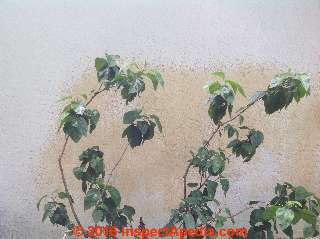 2016/08/13 Colin Frankland said:
2016/08/13 Colin Frankland said:
I have hard yellow orange stains running from under my flat roofed garage which are almost impossible to remove any ideas how to shift them
2016/08/16 Anonymous said:
1st time ever I have orange stain on my stucco exterior wherever I have hibiscus plants.
The stain follows the shape of the plant beside it, so I know it must be from the pollen. Any idea how to remove it? Thanks - Anonymous by comment & by private email
[Click to enlarge any image]
Reply: Tips from removing Hibiscus or other flower pollen stains from walls:
For space we have moved this discussion to a separate article.
Please See POLLEN STAINS on BUILDINGS
Catalog of Types of Stains on Building Surfaces
In the following guide we list types of stains by stain color & appearance, by building location or material, and by stain cause. We distinguish among the following stuff that may stain or be found growing building roofs, walls, or other surfaces, with extra focus on asphalt shingle roofs as well as other roofing materials such as wood shingles, wood shakes, roll roofing, and even slate or tile roofs.
Some of these types of roof stains or discoloration are only cosmetic in nature, while others may indicate growths that are likely to reduce the roof covering life. A more detailed, illustrated version of the list below is given
at STAIN DIAGNOSIS on BUILDING EXTERIORS.
- Algae-caused black or green stains on roof or other building surfaces - Some photos of black algae stains are
at BLACK ALGAE STAINS On Asphalt Shingles.
For details on roof algae see ALGAE STAINS on ROOFS,
and ALGAE STAIN TEST METHODS.
Algae can produce black stains on asphalt roofing products
Also see ALGAE, FUNGUS, LICHENS, MOSS COMPARED.
And see STAIN DIAGNOSIS on STONE for examples of algae staining on other building surfaces. - Black stains on asphalt roofing products such as asphalt shingles or roll roofing, caused by extractive bleeding (product defects) -
see EXTRACTIVE BLEEDING on SHINGLES
and
see ROOFING MATERIAL DEFECTS environmentally-caused roof shingle stains. - Black, brown, or gray stains on roofing products due to debris left on the roof surface, such as piles of leaves and organic waste from nearby trees.
See DEBRIS STAINING
and
see PROXIMATE CAUSE of ROOF SHINGLE STAINS - Black or other colored stains on roof surfaces may be caused by soot from chimneys, both wood-fired and oil-fired devices. Black or other colored stains may also appear on roof surfaces from nearby industrial activities. See SOOT STAINING
- Black stains on building interiors: such as on carpets, drywall, or trim:
see STAIN DIAGNOSIS on BUILDING INTERIORS and
then STAIN DIAGNOSIS on BUILDING INTERIORS and
also see STAINS on INDOOR SURFACES, PHOTO GUIDE - Brown or red stains on roof surfaces are often caused by rust from wearing steel flashing or other on-roof metal products.
See RUST STAINS on SHINGLES - CATALOG OF BIOLOGICAL SUBSTANCES THAT ALTER STONE OR OTHER INORGANIC MATERIALS lists the causes and types of damage that raise aesthetic and conservation issues on cultural artifacts, buildings, and art works.
- Chimney stains on roofss -
see SOOT STAINING - Black Soot Stains on Roof Shingles Around Chimneys
and see PROXIMATE CAUSE ROOF SHINGLE STAINS - Debris stains on roof shingles -
see DEBRIS STAINS on ROOFS - Black Debris Stains on Asphalt Shingle Roofs from leaves, algae, dirt - Extractive bleeding stains on asphalt roofs -
see EXTRACTIVE BLEEDING on SHINGLES
and see ROOFING MATERIAL DEFECTS
and see PROXIMATE CAUSE ROOF SHINGLE STAINS (types of roof stain by color, location, probable cause) - Grafriti on building surfaces
See GRAFFITI REMOVAL FROM BRICK CONCRETE STONE SURFACES - Green roof stains on roof shingles, clay tiles, cement tiles, and asbestos cement roof shingles or newer fiber cement roof shingles are often caused by algae.
For details see ALGAE STAINS ON ASPHALT ROOF SHINGLES. Moss on roofs is also often green and should be unmistakable in appearance.
See ALGAE, FUNGUS, LICHENS, MOSS on ROOFS. - Lichens growing on building surfaces - Lichens are not the same growths as moss or algae, and are difficult to remove without damaging the roof surface.
See LICHENS on STONE SURFACES, and also
see LICHENS on ROOFS for details about how lichens can cause roof damage.
See METHODS FOR CLEANING STONE SURFACES
and ALGAE, FUNGUS, LICHENS, MOSS on ROOFS for a guide to preventing lichen growth and stains.
Also see ALGAE, FUNGUS, LICHENS, MOSS COMPARED for an explanation of the difference among these. - Mold or fungus growing on roof surfaces or on other building surfaces -
see ALGAE STAINS ON ASPHALT ROOF SHINGLES.
See MOLD in BUILDINGS for a guide to looking for mold contamination in or on buildings, and
see WHAT MOLD LOOKS LIKE for a guide to just what mold looks like on building surfaces.
Be sure also to see STUFF that is MISTAKEN for MOLD to avoid becoming excited about harmless substances that people think are toxic mold. If you know your building has a mold problem,
Also see ACTION GUIDE - WHAT TO DO ABOUT INDOOR MOLD. - Moss on roofs and other building surfaces:
see ALGAE, FUNGUS, LICHENS, MOSS on ROOFS,
and GREEN STAINS on STONE
Green or other colored mosses are a bit easier to remove than lichens on roofing surfaces, but both can carry away mineral granules and damage the roof surface. Moss tends to hold more water and moisture on the roof surface.
So in our opinion moss is more likely to damage a roof surface than lichens or algae.
Also see ALGAE, FUNGUS, LICHENS, MOSS COMPARED. - Pollen stains on building surfaces -
see POLLEN STAINS on BUILDINGS - Roof Stains -
See STAIN DIAGNOSIS on ROOFS where we catalog roof stains and discoloration by stain color, location, pattern, cause - Rust Stains on buildings -
see RUST STAINING - Red or Brown Rust Stains (on shingles) - Soot or Creosote black or brown stains on roof surfaces near or below chimneys -
see SOOT STAINING - Black Soot Stains on Roof Shingles Around Chimneys and
Also see PROXIMATE CAUSE of ROOF SHINGLE STAINS - Stains on stone or masonry surfaces -
See STAINS on STONE, STUCCO DIAGNOSE & CURE to diagnose all colors of stains on stone, stucco and other masonry surfaces.
Also See STONE, STUCCO & BRICK CLEANING METHODS for cause, cure, and prevention - Stucco, stains on - black, white, or other color stains or bleed-out on stucco wall surfaces -
See BLACK STAINS on STONE & STUCCO
See also SIDING EIFS STUCCO PAINT FAILURES - where we discuss white stains blooming through painted stucco - Swarf stains - on metal roofs caused by metallic debris left on the roof surface -
See STAIN DIAGNOSIS on ROOFS - Tar run-down or bleed-out stains on siding or other building surfaces -
See BLACK TARRY RUNDOWN on SIDING above in this article - Tree-caused stains on roofs -
see ROOF SHINGLE STAIN CAUSES - White stains on roof surfaces may be from wash-down of pigments in paint on surfaces above the roof such as a gable end or dormer wall; white or less-black roof surfaces may also be found below copper or aluminum flashing whose salts run down the roof surface in wet weather, preventing algae or moss growth and leaving a white area on an otherwise stained roof surface.
Our article at ALGAE, FUNGUS, LICHENS, MOSS on ROOFS includes a photograph of this condition on a wood shingle roof.
...
Reader Comments, Questions & Answers About The Article Above
Below you will find questions and answers previously posted on this page at its page bottom reader comment box.
Reader Q&A - also see RECOMMENDED ARTICLES & FAQs
On 2021-05-12 - by (mod) -
@Amy, I didn't think so either.This looks like a pretty-new building; As I said, the stained area looks like a synethetic stucco;
I'd want to know what's behind that wall; could be an original application problem such as stuccoing over contaminated or wet surface, or a leak inside or behind the surface.
There is not a shred of visual evidence of impact by a vehicle.
On 2021-05-11 by Amy
100% not from our car
On 2021-05-11 - by (mod) -
@Amy, Ok that helps;If you had hit the wall surely we would see at least a trace of impact damage;
Any possibility of exhaust stains?
On 2021-05-11 by Amy
This is a picture so you can see little more of house and the building company have told me that I have hit the wall & that’s what has caused the damage
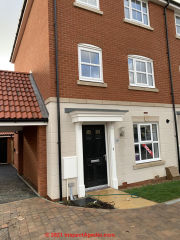
On 2021-05-11 - by (mod) -
@Amy, it looks to me as if that's a synthetic stucco faux column tooled to look like concrete block; I can't see enough of the surroundings to be sure what we're looking-at. If this is a chaseway for a chimney or piping I suspect a leak inside.On 2021-05-11 by Amy
this is at the front of my house to the side.
On 2021-05-11 - by (mod) -
@Amy,What are we looking at is that a concrete block chimney enclosure or a structural column is it next to a garage or an entry or what?
If it's a type of stucco on a hollow wood framed chaseway I suspect there may be a leak inside and mold growth.
On 2021-05-11 by Amy
Just moved into new build & gave this mark on the wall any suggestions what’s caused it?

On 2021-05-02 - by (mod) -
@Ann Larsen,I'm am old guy but I've never heard of shotgun mold so that's pretty interesting and props you can tell me more. But in any case the material in your photo certainly looks like mold.
Fortunately we don't need to know the mode to genera and species to know what to do with mold on a building.
Clean off the mold and fix the cause.
On abuilding siding. that might be that the siding is too shaded.
On 2021-05-02 by Ann Larsen
Looks like someone threw a small black sticky paint ball bullet, the way it spreads out. All pics of shotgun mold that I've seen doesn't look like this.
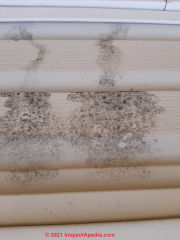
On 2021-04-26 - by (mod) -
@Debi,
I suspect that at some point during its life the gutters on that roof are not kept clear and water spilled over splashing onto the ground along the foundation and splashing mud up onto the wall.
That's just a guess because I can't see too much in the photo. It's a little blurry. I'd like to have a closer look also at the underside of those soffits because in the photo and looks very dark. We want to know if something's going on there. Or may just be shadows in your photo.
On 2021-04-25 by Debi
Any idea what may have caused the yellow stain along the bottom of the exterior wall of this house and how to remove it and ensure that it doesn't return? (see photo)
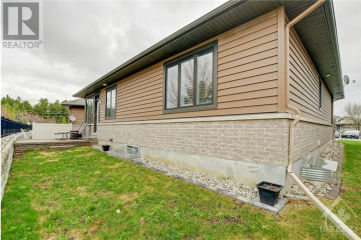
On 2021-04-11 - by (mod) -
@Allyson HP, forgive me but I don't see the stain; or are you referring to what looks a bit like a shadow line in the center of your photo, under the bottom edge of the board to the "left" as the photo is positioned?On 2021-04-11 by Allyson HP
I have tried so many things to test clean this yellow stain and nothing works! Also called for a quote for a soft wash and they were unable to identify it either.
It’s underneath the siding on ~50% of the house. Evenly distributed and not one area more than the other. We bought this house last summer and it definitely was not there!
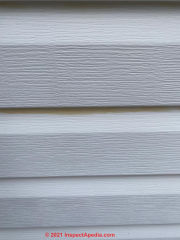
On 2021-03-24 - by (mod) -
@Tim,1/2 to 2/4" should be enough;
Watch out: be sure that there is Z-flashing that extends up behind the siding and an inch or two about the top of the cutout;
Watch out: when cutting the batttens take care not to let the saw blade cut the flashing behind the siding.
On 2021-03-24 by Tim
The builder agreed to cut back the battens to see if it helps and be sure the battens are sealed with caulk. How much do you recommend taking off the battens? Should we caulk under the batten or should that be open to let in water escape? I believe the nail, as shown in the picture, is rusting. It was covered by paint with the last fix attempt.
Do you think that was water pooling on top of the horizontal trim board or behind. When talking to the builder, it doesn't seem likely that water could've gotten behind the horizontal trim board unless the batten is over the seam between two 4x8 sheets of siding above the trim board. I'd also like any suggestions on how to treat the nail.
Once the repairs are made, I will retreat and use the special paint.
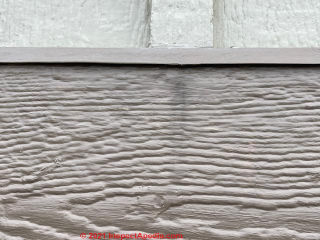
On 2021-03-24 - by (mod) -
@Tim,
Before going to the trouble of removing or shortening the battens I'd simply clean the surfaces and make sure that the batten sides and bottom are well sealed; keep in mind that if the upper batten sides leak wind-blown rain behind the batten that water will run down the batten back surface, remain trapped, and corrode nails and make stains that want to leak out, and might even lead to rot damage.
So thorough sealing is important.
Sometimes on buildings I see fungi or algae growing on some surfaces where there's more shade, even when the drainage is good; in turn those organics will cause run-down stains on siding.
Unless we're going to chop down our trees (ugh!) we may have left just periodic cleaning and use of fungicidal-treated paints and sealants.
On 2021-03-24 by Tim
Thanks for your response. Here's a closeup of one of the battens, the flashing underneath and, in this case, a rusting nail that is probably the source of that streak. It also looks like the batten is flush with the horizontal trim board.
Of the two options you recommended, what option will most likely cure this problem (remove and shorten the batten or caulk around the joint)?
If caulking, should it just be applied in the corner to divert the water away from the intersection of the batten and trim board. Also, how should I treat this nail (grind it down, paint with anti-rust treatment, caulk and paint)?
On the other battens, the nails are covered with paint. Should I do the same thing with them or should I try to remove and replace the nails? Thanks
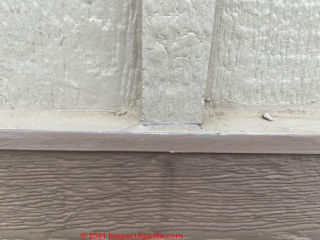
On 2021-03-23 - by (mod) -
@Tim, thanks: great siding stain question and photo.
It's likely that moisture collects at that horizontal lip under the bottom ends of those vertical battens whose location marks the start of each of those dark vertical stains down the siding below.
That would happen if the batten ends were either not stopped shy of the horizontal trim upper surface below their ends - sufficient to assure good drainage and drying, (or were not sealed at that location), and if, then, that moisture either is rusting a fastener at each batten or is promoting a bit of dirt collection or mold growth that washes down in a straight line from its reservoir at subsequent rain storms.
I would inspect those battens: I can't tell from the photo if they're wood strips or raised metal ribs or something else; and I'd decide how best to seal them and their fasteners; then I'd clean the siding.
On 2021-03-23 by Tim
Can you identify what is likely causing the vertical lines extending down from the batten and board LP siding? How can I eliminate the lines?
On 2020-08-02 by Mary
I have very dark spots on front porch columns that look like blobs. it’s like the columns are breaking out with something. What could the dark blobs be?
On 2020-07-30 - by (mod) -
Sean
It's possible but not likely that a spray insecticide affected paint on brick. MOre likely it's a water issue.
On 2020-07-30 - by (mod) -
black stains on stucco exterior walls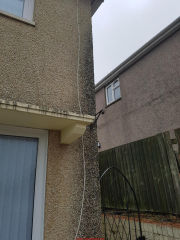 Typically that black stain is an algae or fungus appearing where water is running down the stucco exterior.
Typically that black stain is an algae or fungus appearing where water is running down the stucco exterior.
On 2020-07-29 by Tina
What is causing this?
Upon closer inspection, the back stain has tiny reddish spurs.
My neighbour has an extremely overygrown conifer tree close to the side of my property.
Their house also has the staining, but no other houses are effected in the street.
On 2020-07-28 by Sean Kelley
Can someone tell me if the stains, yellowing and bubbling is a result of an insecticide that was painted on our bushes? Thanks.
We have had some stains appear on the side of our house recently.
Since our homeowners association hires a landscaping company that sprays insecticide or something on our bushes, which we think it may have had a chemical reaction to the paint. Any ideas?
On 2020-06-26 - by (mod) -
 I think this is a brick veneer wall home, though I didn't see weep openings or other construction details to confirm that.
I think this is a brick veneer wall home, though I didn't see weep openings or other construction details to confirm that.
Anything that leaks into the veneer cavity an cause an external stain as can - more-easily - something that bleeds down or runs down the exterior wall.
If the stain is due to water you will be able to measure a moisture difference between the stained area and other areas of the wall.
see MOISTURE METER CHOICES and use a surface sensing type not a pin type moisture meter
If the stain is un-changing and *IF* it were water, then we need to find a surprise leak (like AC condensate or some other source)- else if it were water it'd dry out and diminish
If the stain is not water it may be a rundown from a window or shutter, a painted surface, or (uncommon) a spill down the wall. Was any work done on the exterior of the home? Could someone have spilled, then tried to clean, something on the wall?
And have you looked closely behind the shutter and below and around the window sill and trim?
Finally: I would be very surprised to find this stain is water wicking up from ground level: the shape of the stain is wider at top than bottom: opposite of what you'd expect if there were a moisture source at ground level.
On 2020-06-26 by Nick.
Thank you for responding to my question. I have actually stood outside during heavy rains to look for a runoff, but nothing happening there.
There are no other signs of anything similar to this anywhere else on the house. I do know this had to come about somewhere between 2013-2019, because we moved in about a year ago (2019) and it was there, and I saw a 2013 pic of the home and it wasn't there at that time. I know the previous home owner before us replaced all windows in 2017. The stain is consistent, never changing in size or shape.
We do have downspouts at both ends of the front of the home that drain direct into the ground, but I'm not sure what direction the water flows. I would imagine it runs away from the home, but there is a drain that runs underground on my driveway the full length of my garage door.
I don't know if maybe somehow the downspout drainage runs the length of the house to the drain on my driveway in front of my garage door and there could be a leak underground where the stain is running up the wall? I'm not sure how in ground drainage works, but that would be a lot of underground drain to run from one end of the house to the other (about 75 feet).
There are no signs of any water stains whatsoever on the inside of the home. Also attached a pic of the front of the home to give you a full picture. Would you guess from the pic this is caused by water, or could it possibly be some sort of stain from something else? Thanks again.
On 2020-06-26 by (mod) - answer these questions to help diagnose stains on building exterior
Nick
That's an interesting brick veneer stain - at least it looks like a veneer wall.
I note that the stain is below the corner of a window opening and below a shutter. Is it possible that there is or was runoff from either of those during wet weather ? Are we sure that there are no other occurrences of similar, perhaps less-obvious stains below other windows?
In tracking down a building stain like this, let's ask (some of this you've answered already)
When did the stain first appear
What changed or occurred around that time
What's different about this location?
What materials are present beginning at or near the top of the stain
Are we sure by pattern that the stain is spreading down the wall rather than up from the ground
Are there any stains, leaks, spills, movement or other indicators inside the building at this location
Also see
STAINS on BRICK SURFACES
On 2020-06-26 by Nick
Hello. I have a stain on my red brick ranch I cannot identify or remove. The home is located in Ohio and was built in 1954. I have only lived there for a year, however have seen a pic of the home dated 2013 and the stain was not there at that time. It has the appearance of being wet, but the appearance never changes, even if it doesn't rain for two weeks.
It doesn't feel wet, plus the ground and mulch at the bottom are never wet. There are no water pipes behind the wall, just a bedroom and nothing is ever wet inside. So I'm assuming it's a stain, but have no idea what it could be.
I tried scrubbing with Dawn and a nylon brush, and then power washing. Then I tried scrubbing with Goof Off brand spray and then power washing. Of course when I'm power washing and the whole wall is wet, it all looks ok.
But once it dries it looks like the attached pic again. My wife bought some muriatic acid to try, but I'm hesitant with fear of damaging the brick and possibly destroying my shrubs. Any idea what this could be or suggestions? Thanks.
On 2020-02-28 - by (mod) -
It sounds as if it could be efflorescence. Try using the add image button to post a photo so that we can have a look
On 2020-02-28 by Sarah
There is a red stain on the exterior white lime rendered wall. when you touch it it comes off yellow on your finger . what could it be? Efflorescence? Pollen?
On 2019-05-22 - by (mod) -
Ian I'm not sure either
But the pattern of stains doesn't look organic. At least not mold or algae.
It looks to me as if something splashed-on or wet the surface. It would be helpful to see more photos showing more context - what areas are stained?
And to know the country, city, and age of the home.
When did these stains first appear?
Can the stain be removed by mechanical scrubbing such as with a plastic scrubby sponge?
Is there a pollen source nearby?
On 2019-05-22 by Ian
Trying to figure out what is causing these yellow brownish stains on the sides of garage and home. Bleach doesn't seem to remove them
IMAGE LOST by older version of Clark Van Oyen’s useful Comments code - now fixed. Please re-post the image if you can. Sorry. Mod.
...
Continue reading at STAINS on & in BUILDINGS, CAUSES & CURES - topic home, or select a topic from the closely-related articles below, or see the complete ARTICLE INDEX.
Or see STAIN DIAGNOSIS on BUILDING EXTERIORS FAQs - questions & answers posted originally on this page.
Or see these
Recommended Articles
- STAIN DIAGNOSIS on BUILDING EXTERIORS - home
- ALGAE & MOLD STAINS on EXTERIORS
- ANIMAL STAINS & MARKS in BUILDINGS
- CHIMNEY STAINS & LEAKS
- EFFLORESCENCE SALTS & WHITE DEPOSITS
- EXTRACTIVE BLEEDING on SHINGLES
- EXTRACTIVE BLEEDING SIDING STAINS
- GAS FIREPLACE CERAMIC STAINS
- GRAFFITI REMOVAL FROM BRICK CONCRETE STONE SURFACES
- SANDSTONE STAIN CAUSES, CURES
- STAINS on ALUMINUM SIDING
- STAINS ANIMAL / PETS in BUILDINGS
- STAINS on BRICK SURFACES
- STAINS on CONCRETE
- STAIN DIAGNOSIS on ROOFS - home
- STAINS on SANDSTONE, DIAGNOSE & CURE
- STAINS on STONE & STUCCO, DIAGNOSE & CURE
- STAINS on VINYL SIDING
- STAINS on RED CEDAR SIDING
- WHITE DEPOSITS, DUST or STAINS
Suggested citation for this web page
STAIN DIAGNOSIS on BUILDING EXTERIORS at InspectApedia.com - online encyclopedia of building & environmental inspection, testing, diagnosis, repair, & problem prevention advice.
Or see this
INDEX to RELATED ARTICLES: ARTICLE INDEX to BUILDING STAINS
Or use the SEARCH BOX found below to Ask a Question or Search InspectApedia
Ask a Question or Search InspectApedia
Try the search box just below, or if you prefer, post a question or comment in the Comments box below and we will respond promptly.
Search the InspectApedia website
Note: appearance of your Comment below may be delayed: if your comment contains an image, photograph, web link, or text that looks to the software as if it might be a web link, your posting will appear after it has been approved by a moderator. Apologies for the delay.
Only one image can be added per comment but you can post as many comments, and therefore images, as you like.
You will not receive a notification when a response to your question has been posted.
Please bookmark this page to make it easy for you to check back for our response.
IF above you see "Comment Form is loading comments..." then COMMENT BOX - countable.ca / bawkbox.com IS NOT WORKING.
In any case you are welcome to send an email directly to us at InspectApedia.com at editor@inspectApedia.com
We'll reply to you directly. Please help us help you by noting, in your email, the URL of the InspectApedia page where you wanted to comment.
Citations & References
In addition to any citations in the article above, a full list is available on request.
- [1] Hugh Cairns, RHI (Registered Home Inspector), Subject 2 Inspections, Mr. Cairns is a licensed professional home inspector and thermographer serving Kelowna, Vernon, and Penticton, British Columbia. Tel: 250.808.5777, Email: okanagan@subject2homeinspections.com
- Soiling and Cleaning of Building Facades (RILEM Report), L.G.W. Verhoef (Editor), Routledge; 1 edition (November 3, 1988), ISBN-10: 0412306700, USBN-13: 978-0412306709
The report of a comprehensive investigation by RILEM which examines all aspects of the cleaning of facades, subject to soiling by both biological and non-biological agencies. The contributors are international authorities working in this field giving essential advice to all those who need to know how to approach the problems connected with the soiling and cleaning of building facades. - Staining, Prevention of Premature Staining in New buildings, Phil Parnham, Taylor & Francis; 1996, ISBN-10: 0419171304, ISBN-13: 978-0419171300
The appearance of ugly staining early in a buildings life, ruins an otherwise pleasing appearance, tarnishes the image of the owners and gives rise to costly refurbishment works. In this book Phil Parnham raises a number of questions that should be considered whenever a new building is being designed or built. These are: * why has staining become so prominent; * what causes premature staining; which parts of new buildings are likely to be affected; * how can it be avoided? By using a number of highly illustrated case studies, the author answers these questions and ends by suggesting measures that should be taken by all design and construction professionals to prevent premature staining. - In addition to citations & references found in this article, see the research citations given at the end of the related articles found at our suggested
CONTINUE READING or RECOMMENDED ARTICLES.
- Carson, Dunlop & Associates Ltd., 120 Carlton Street Suite 407, Toronto ON M5A 4K2. Tel: (416) 964-9415 1-800-268-7070 Email: info@carsondunlop.com. Alan Carson is a past president of ASHI, the American Society of Home Inspectors.
Thanks to Alan Carson and Bob Dunlop, for permission for InspectAPedia to use text excerpts from The HOME REFERENCE BOOK - the Encyclopedia of Homes and to use illustrations from The ILLUSTRATED HOME .
Carson Dunlop Associates provides extensive home inspection education and report writing material. In gratitude we provide links to tsome Carson Dunlop Associates products and services.


